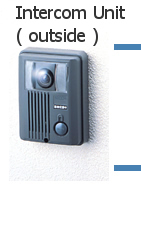|
Face Detection Technology
The newly developed face detection technology can be explained through the difference from current face detection/recognition technologies.
Face detection technology is locating the position of human faces in an arbitrary image. Recent models of digital cameras and printers now include this technology, which is used mainly to adjust brightness or focus.
On the other hand, face recognition is a technology to determine the individual that the face belongs to. Commercialization of this technology has been limited, mostly to applications in access control or detection in a crowd.
Our approach to face detection is unique, in that we determine whether a face in a given image is identifiable by a human.
Face Detection Function
By equipping an intercom with our face detection technology, it becomes possible to determine beforehand whether a visitor's face can be identified by the resident. In other words, it provides a way to determine whether the face or figure is obstructed.
  
Fig.1 SECURIFACE Interphone
SECURIFACE Operation Overview
The intercom can ring the doorbell in three different ways, depending on the face detection results of the visitor.

Fig.2 Face detection behaviors
Effectiveness of Face Detection
We can analyze the effectiveness of the SECURIFACE Interphone system by examining the behavior of both the residents and visitors.
Effects on Visitors
If a visitor's faces or body is obstructed while operating the intercom, the unit will play a pre-recorded message, with the following implications:
- The non-typical response (voice, instead of a bell) acts as a deterrent against visitors with nefarious intent.
- Ringing the doorbell cannot be used to determine whether the resident is present.
Effects on Residents
If the face of the visitor is not clearly visible, the doorbell will ring differently:
- Residents can exercise due caution when manually confirming the visitor on the monitor.
If configured to stay silent under such a scenario:
- The residents do not have to answer the door.
- Minimize the risk of opening the door out of concern about who is visiting.
|







